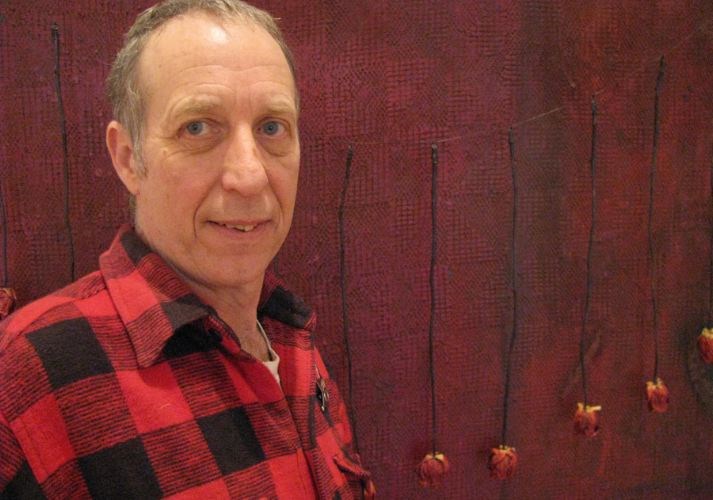Most artists know that clichs are to be avoided like the plague. But what if the stereotype is the whole point of the art? Somewhere on that disputed territory is where Jeff Molloy wanders around. He is looking for his land, especially the kind without dirt and real estate.
Molloy's art is an extensive, silent discussion on the topic of Canadiana. He focuses heavily on the coming together of cultures, which is the single chief characteristic of Canadian modern society. It's who we are; it's what we are.
The most dominant visual word Molloy uses in his Prince George artistic debut is "Mtis." This word pertains, in a dictionary sense, to descendants of shared aboriginal-European bloodlines, but it has also come to mean, in a larger symbolic sense, that peculiar condition playing out on this country's soil whereby people from here, there, and everywhere are in the process of blending into a definitive national identity. We are the only nation on earth that does this: embracing with a smile all the different backgrounds of the world and celebrating their customs at face value, adopting them as our own, even if we don't individually descend from that. It is all part of our cultural fabric.
The Hudson's Bay Company's white multi-striped blanket, the HBC's red and black "frontier" blanket, the voyageur toque, the mackinaw jacket, the hockey jersey - sure these things are clichs of Canada, but there is truth woven into those symbols even if those truths are beautiful and horrible, prideworthy and shameful at the same time.
Molloy discusses these clichs and many other physical elements of Canada in his current exhibition at the Two Rivers Gallery in his exhibition entitled Looking For My Land. He feels he can get away with speaking up about all manner of culture because he has none but the generic Canadian one we are all bestowed with.
"At six days old, I was adopted," Molloy said. "I have no idea about my heritage. So, I am a culturalist. I have no confines on what I can say about place in culture. I gravitate instead towards values and principles. There are some I hold dear and I believe they are ones Canadians hold as foundational to the national identity. I see those clearly in the life of Louis Riel and many of the Mtis community even today."
Sense of place, of personal roots, is a driving force inside the primal human brain. Evidence of that can be found in the biggest of headlines around the world and right here in our own territory. Words like Jerusalem, Gaza, Crimea, Islamic State, and Tsilhqot'in have been some of the most emblematic terms of the past year and they resonate far beyond geographical meanings.
Like the issues themselves, Molloy's artwork on the topic of cultural geography has angry tones, funny tones, puzzling tones. He's making a speech, but he keeps his distance from crossing the line into preach.
"Ambiguity," he said, like a one-word mission statement for artists. He learned it from an art teacher who used famed novelist/short-story author James Joyce as an example. When one of Joyce's characters, a father, repeatedly walked into the family home from a hard day at the mines, perpetually weary from the low-paying work that kept him from connecting to his family, and how this represented the miner's son's impressions of their lot in life, Joyce didn't spell all this out in a paragraph of literal description as was just done here. Joyce wrote "he came through the door heavy."
That, said Molloy, is the efficiency every serious artist strives for. It gives the key information but, by using the tool of ambiguity, leaves all the implications up to the powerful imagination of the reader.
Apart from that, there are practical tools Molloy uses to make his art.
"I'm a sculptor who loves to paint, so I'm always looking for something that crosses over," he said. "My initial training was as a stone carver and then I became a pipefitter, so I'm really comfortable making things, including the art, and including the tools I use to make the art."
As a true do-it-yourselfer inside his artist's workshop on Gabriola Island, he has gone in search of the roots of art process itself. He is a modern champion of the encaustic form of painting, which uses hot beeswax blended with pigments obtained from nature. It is a technique used as early as the ancient Egyptians and is experiencing a modern resurgence thanks to the likes of Molloy. It is an art process that further serves the rustic, history-based, nature-based, simple industry points made by the art show itself.
"Even the materials I use are part of the message," he said.
Looking For My Land opens Thursday night at the Two Rivers Gallery. Molloy will be on hand at 7:30 p.m. to discuss the work, and a casual party will follow. He will also be available on Saturday from 10 a.m. to 3 p.m. for a workshop at the gallery entitled The Art of Assemblage (preregistration is required to attend).



